st. louis
The icon is on display in two locations — the Catholic University of America’s Columbus Law School in Washington, D.C., and at The Episcopal Church of the Holy Communion near St. Louis. In November, The Daily Signal, a conservative news outlet, published a story about the CUA edition of the painting. Since then Kelly Latimore has been receiving death threats.
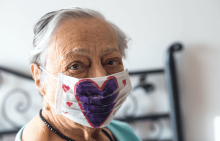
Founded in 1872 by the Sisters of St. Joseph (CSJs) as a home for ill and retired members, Nazareth found itself among many care facilities making the difficult decision to confine residents to their rooms as the coronavirus tore through the nation in early March. Even with their efforts, the Nazareth community has lost seven Sisters and 30 residents in total to COVID-19.
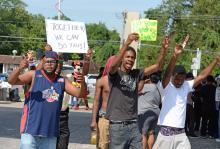
The test for religious leaders in this context has been nothing short of a demand for a prophetic voice which sees, names, and challenges the reality of a system that destroys the lives of some while parading as “law and order” for others. Faith leaders are finding themselves tangled in a quagmire of competing rhetoric about what makes for peace, walking the line of proclaiming prophetic vision amid a culture, a church, and a people tightly wrapped in the clutches of white supremacy.
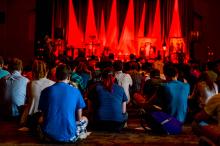
Participants joined with local religious leaders and city residents to walk through the city, stopping at various places of worship to sing and pray, in a demonstration of unity. The Walk of Trust ended on the campus of Saint Louis University, where Archbishop Robert Carlson of St. Louis, who first conceived of the meeting, spoke alongside the Rev. Dr. Traci Blackmon, a pastor in Florissant, Mo., and a leading voice in the response to Michael Brown’s death.
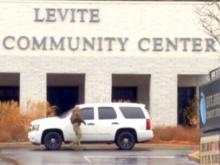
Enrollment has dropped at more than a quarter of Jewish Community Center preschools since a wave of threats against JCCs began in early January.
“I’m starting with the most difficult news, which is simply that more JCCs indicated something of a decline — but the majority have not,” said David Posner of the Jewish Community Center Association of North America, sharing the results of the umbrella group’s latest member survey.

President Trump, long-chided for failing to address a surge in hate crimes, began his first address to Congress by invoking Black History Month, and condemning recent threats against Jewish institutions and the shooting of Indian men in Kansas City.

The Rev. Leah Daughtry stood in front of fellow black Christian leaders and told them they will need to work harder for social justice.
“If you’ve been feeding them, now clothe them,” said the Pentecostal pastor and 2016 CEO of the Democratic National Convention Committee at a conference last week. “If you’ve been clothing them, now console them. If you’ve been at a march, now lead the march. If you’ve been at a rally, now organize the rally.”
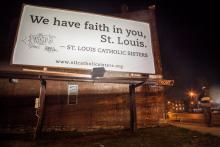
This Mississippi River city and the surrounding area have taken some hits over the past year, from the ongoing racial tensions over police shootings in Ferguson to the deadly and costly floods that struck the region earlier this year. Even St. Louis’ pro football team has bailed, as the Rams announced in January that they are decamping to the sunnier climes of Southern California.

St. Louis Archbishop Robert Carlson has issued a letter calling on parishes to seek alternatives to Girl Scouts, arguing that the program and related organizations conflict with Roman Catholic teaching. The Archdiocese of St. Louis isn’t directly kicking Girl Scout troops and activities off church properties, but is suggesting they and their cookies may no longer be welcome in the fold.
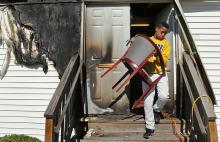
David Lopez Jackson, 35, was charged Oct. 30 with setting two in a string of seven church fires this month, but authorities say they don’t know the motive.
The charges were two counts of second-degree arson. Jackson was being held in lieu of $75,000 bail, according to court documents.
Forensic evidence linked him to the fire on Oct. 18 at Ebenezer Lutheran Church; video of his car near New Life Missionary Baptist Church, links him to the fire there on Oct. 17, police Chief Sam Dotson said. Both churches are in the city of St. Louis.
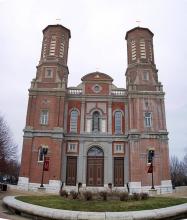
Someone set fire to a seventh church in this city Oct. 21, the latest in a rash of arson fires targeting predominantly black churches.
But the Shrine of St. Joseph on the outskirts of downtown in what’s known as Columbus Square, is not a black church. It was predominantly white and Roman Catholic, dating back to 1843.
Capt. Garon Mosby of the St. Louis Fire Department said no one was injured in the blaze. No one was inside the church when it happened.
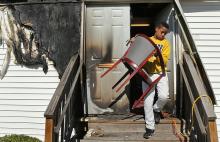
Police are stepping up patrols and trying to develop a profile of whomever has set six fires outside churches in predominantly black neighborhoods since Oct. 8, Police Chief Sam Dotson said.
The American Civil Liberties Union of Missouri and the Anti-Defamation League suggested a racial motive may be at play. In a prepared statement, the ACLU of Missouri’s executive director, Jeffrey Mittman, called the fires “domestic terrorism.”
“It is a sad truth that, throughout our nation’s history, African-Americans often have been met with astounding violence when they demand equality,” he wrote.
“Those who commit this violence seek to instill fear. This is why arson against predominantly black churches has been a frequent tool of white supremacy.”
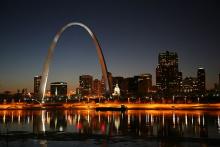
A reward of up to $2,000 is being offered for information leading to the arrest of the culprit in a string of fires that have now hit six predominantly African-American churches in and around St. Louis.
Ebenezer Lutheran Church, at 1011 Theobald Street, is the latest church to report damage.
Capt. Garon Mosby, spokesman for the St. Louis Fire Department, said members of the congregation called authorities about 9:25 a.m. Oct. 18 after arriving for a worship service and noticing damage. The fire was already out by the time firefighters arrived, Mosby said.
Although he could not provide additional details, Mosby said that the damage was not extensive. But that the incident was being investigated along with the five other church fires that have happened in the area since Oct. 8.

I am the Dean of Students at Covenant Theological Seminary, the National Seminary of the Presbyterian Church in America (PCA). I am the pastor of South City Church in Saint Louis. South City Church is a PCA congregation, and it is predominantly white. I am a retired full colonel PCA Army chaplain. I was born and raised in North Saint Louis city. My father now lives in Ferguson, Mo. I am a black man. If that comes as a shock, believe me I understand; it is a shock to me every morning when I wake up and go to work at Covenant Seminary in West Saint Louis County, a mostly wealthy and white suburb. It shocks me every time I walk into my church in South Saint Louis and remember that I am one of only 47 black pastors in my denomination and that I work in a mostly white conservative, evangelical church. I am constantly at the feet of Jesus asking for help in navigating the racial, cultural, and generational waters around me. It is a wonderful opportunity, but it is challenging for someone like me; I grew up believing that white people never really wanted to be in close proximity to black people unless they were the ones controlling the situation. There was also the belief that the only black people who were successful in white organizations were the ones who did not mind being tokens without real dignity in the system. There may be people who believe these things about me. I have even questioned myself as to why I have been given so many opportunities in the PCA. I sometimes don’t like the answers that come to mind.
Recently, a young pastor asked my opinion on cross-cultural ministry. He asked me how an African American got two positions as both Covenant’s Dean of Students and as pastor of South City Church. I explained, “it makes no sense, since so much of the history in our denomination makes me the wrong guy for the job! But through God’s sovereign will, here I am!” His response was, “I guess God always sends the wrong messenger.”

It is difficult to understand why people, particularly Christians, view a statement as patently obvious as “Black Lives Matter” as a subject for controversy. However, sometimes the most obvious things still need to be said.
So:
Black lives matter because God made every one of us in God’s image. Black lives matter because the Bible tells us that we are part of a body and the eye cannot say to the hand, “I don’t need you.” Black lives matter because God pays particular care to those crying out under the burden of injustice and oppression.
As people of faith in a neighborhood that has been rocked by protests, tear gas, and arrests, we have sought to stand in solidarity with those who are groaning under the burden of oppression. We offer some physical support — hand warmers, a cup of coffee, an extra pair of socks, but we also offer our presence. The Bible often refers to Christians as “witnesses,” and there is something important about simply standing next to our neighbors in the streets and seeing what is actually happening.
We firmly believe that Jesus needs to be down in the clouds of tear gas and he lets us, his people, participate in his reconciliation by bringing him there with our own two feet. Christians, and particularly evangelicals, need to be in the streets. Our neighbors are just outside our doors, crying out that the system is broken and that our culture doesn’t value the lives of our brothers and sisters. We, as Christians, believe in sin and brokenness and we need to live out our belief that God values all of God’s people even as our culture picks and chooses who is worth caring about.

At the point of the writing of this article, it has been 124 days since unarmed 18-year-old Michael Brown was shot six times and killed by Ferguson police officer Darren Wilson.
Blocks from the spot where Brown lay dead in the tightknit Canfield neighborhood of Ferguson, Mo., protestors filled West Florissant Avenue, where Brown had been only minutes before his death. They were met by the local police force decked out in camouflage and body armor, armed to the gills with military-grade weapons, and rolling around in armored cars. Many commented that the streets of Ferguson looked like Fallujah.
It was both shocking and clarifying at once.
For the first time, Americans witnessed real-time outcomes of the National Defense Authorization Act, which funnels military weapons left over from past wars to local police municipalities across the country — in theory, to fortify local efforts in America’s drug war. Cable news cameras swarmed as wartime weapons, tactics, and protocols were enacted on unarmed, mostly black citizens exercising their First Amendment rights to assemble and exercise free speech.
Here’s the thing about war: There are only enemies and allies. There is no in-between.
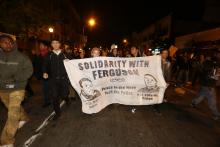
In an intimate conversation between Jesus and his disciples, just before Jesus predicts that Peter will deny him three times, Jesus asks Peter, “Will you lay down your life for me?” As Jesus’ crucifixion approaches, his question to Peter becomes reality, and the people who know of Jesus or his movement must make a choice — to suffer and die with Jesus, or to slip away in fear and passivity — to welcome Christ, or to reject Christ.
Peter is certainly not the only one to face this decision. Judas must choose to betray Christ or not; the high priests must choose between power and mercy; Pilate must choose the approval of the people or trust his own conscience. These individuals, however, do not stand alone in their decision-making, but among one of the strongest but often overlooked characters in Scripture — the crowd. As Jesus stands before Pilate, it is not Pilate who truly holds power — it is the raging crowd before him that demands for the freedom of Barabbas and the crucifixion of Jesus.
When looking back on the crowd’s decision, it is easy to see how wrong it was until we begin to ask where we stand among the crowd in our time. In the case of Ferguson and the grand jury’s decision on Darren Wilson, most of us stand in the crowd, waiting to see what the grand jury and the state may do while we decide what we must do. All eyes are on the jury, yet many of us who are watching realize that the real power does not reside in Gov. Jay Nixon or the grand jury, but in us. Just as it is the crowd who sways Pilate to crucify Jesus, so it is we who can determine whether justice comes in Ferguson and everywhere where racism exists. As bell hooks writes, “Whether or not any of us become racists is a choice we make. And we are called to choose again and again where we stand on the issue of racism in different moments of our lives.” Today, we have another choice. The grand jury is under the spotlight, but we are all responsible.
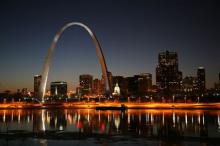
Some might argue that if there is one thing this city could use more of right now, it’s compassion.
Even before civil unrest surfaced in the region after Officer Darren Wilson killed Michael Brown in Ferguson, local leaders were trying to find a way to cultivate more of it. But how exactly? And how would we know when we had enough?
Unlike other commodities, compassion is difficult to quantify.
But that hasn’t stopped the formation of a worldwide movement for compassionate cities. St. Louis is the latest municipality to vie to be part of the sympathetic pack, which includes Louisville, Ky.; Atlanta; Nashville, Tenn.; Seattle; and other cities from around the world.
On Nov. 13, in an effort to bring St. Louis one step closer to officially signing on to what noted religion scholar Karen Armstrong coined as the Charter for Compassion, advocates will host the first-ever town hall meeting dedicated to the crusade.
“We’re wired for compassion and what we would hope for and work toward is compassionate energy and action becoming an increasing factor in decision making and planning across the St. Louis region,” said David Mehl of the Interfaith Partnership of Greater St. Louis, a key member of a group of about 30 local leaders pushing that the city, like others around the nation, agree to the charter’s terms.
“The situation in Ferguson and beyond makes this all the more relevant.”

WHEN JOHANNES BRAHMS first played his German Requiem in Vienna in 1867, the audience was shocked. In fact, scholars report that some “hissed and booed and behaved quite boorishly.”
This October, when the St. Louis Symphony performed the same piece along with German composer Detlev Glanert’s arrangement of Brahms’ Four Preludes and Serious Songs, it elicited a similar response.
Not to the work itself, but to what occurred during intermission.
As conductor Markus Stenz took the stage, two audience members began to sing. In strong, clear voices, they performed Florence Patton Reece’s famous justice hymn: “Which side are you on, friend? Which side are you on?” Nearly a dozen more scattered throughout Powell Hall joined in. While the audience watched in stunned silence, a banner unfurled from the balcony with a silhouette of a man’s face. It said: Requiem for Mike Brown 1996-2014.
As in Vienna, there were some boos from the audience and a few expletives—more disruption following the Aug. 9 shooting death of Michael Brown, an unarmed African-American teenager, by white police officer Darren Wilson. While the Vienna audience complained that Brahms’ music was too religious for a secular setting, one St. Louis symphony-goer asked, “Is Powell Hall a proper venue for a protest?” And a Catholic priest challenged: “Instead of chanting ‘Which side are you on?’ further dividing the community, try singing ‘How can we heal?’”
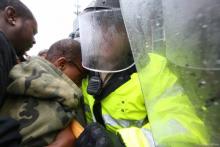
“Get the word out. Teach all these things. And don’t let anyone put you down because you’re young. Teach believers with your life: by word, by demeanor, by love, by faith, by integrity.” –1 Timothy 4:12 (The Message)
In our recent book Forgive Us: Confessions of a Compromised Faith, Mae Cannon, Lisa Sharon Harper, Soong-Chan Rah, and I call the American church to a posture of repentance due to all the times we have not only been on the wrong side of history, but on the wrong side of God.
As an organizer and director of the AMOS Project in Cincinnati, I’ve discovered that a humble spirit of repentance is critical to powerful work around racial and economic justice. There can be a strong temptation to replay colonialism by having all the answers and believing we are God’s gift to the oppressed. We white evangelicals are particularly susceptible to this arrogant path. Humility and a repentant spirit are key to a healthy engagement and partnership in our work.